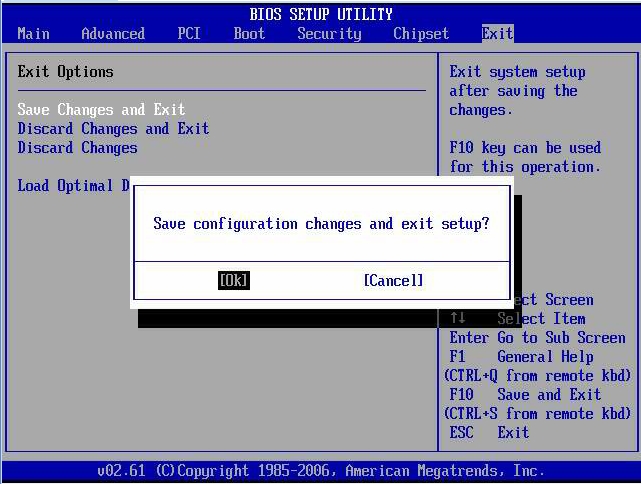8 Server Node Basic Input/Output System (BIOS)
The Basic Input/Output System (BIOS) has a Setup Utility stored in the BIOS flash memory. The Setup Utility reports system information and can be used to configure the BIOS settings. The configurable data is provided with context-sensitive help and is stored in the system's battery-backed CMOS RAM. If the configuration stored in the CMOS RAM is invalid, the BIOS settings return to their default optimal values.
Note:
The BIOS menus shown in this chapter are examples. The BIOS version numbers, menu information, and menu selections are subject to change over the life of the product. You should not change the factory settings unless prompted to do so by Oracle Service personnel.Oracle Database Appliance X6-2 Series BIOS Utility
This section describes the Oracle Database Appliance X6-2 series BIOS utility. If you have Oracle Database Appliance X3-2, Oracle Database Appliance X4-2, or Oracle Database Appliance X5-2, go to Oracle Database Appliance X3-2/X4-2/X5-2 BIOS Utility. If you have Oracle Database Appliance (original version), go to Oracle Database Appliance (Original Version) BIOS Utility.
All settings are set to the optimal defaults at startup.
Caution:
You should not configure system BIOS settings. Oracle Database Appliance patch software will do this for you. The only time you might need to configure BIOS settings would be if requested to do so by Oracle Service.The following topics are included:
Setting Up BIOS Configuration Parameters
This section describes the BIOS configuration parameters for Oracle Database Appliance X6-2 series.
Note:
The links in the following table take you to instructions outside of the Oracle Database Appliance library to the Oracle Server X6-2 documentation library. Use your browser's Back button to return to the Oracle Database Appliance library.| Oracle Database Appliance X6-2S | Oracle Database Appliance X6-2M |
|---|---|
BIOS Setup Utility Menu Options
This section describes the BIOS utility menu options for Oracle Database Appliance X6-2 series.
Note:
The links in the following table take you to instructions outside of the Oracle Database Appliance library to the Oracle Server X6-2 documentation library. Use your browser's Back button to return to the Oracle Database Appliance library.| Oracle Database Appliance X6-2S | Oracle Database Appliance X6-2M |
|---|---|
Oracle Database Appliance X3-2/X4-2/X5-2 BIOS Utility
This section describes the Oracle Database Appliance X3-2, Oracle Database Appliance X4-2, or Oracle Database Appliance X5-2 BIOS utility. If you have Oracle Database Appliance X6-2 series, go to Oracle Database Appliance X6-2 Series BIOS Utility. If you have Oracle Database Appliance (original version), go to Oracle Database Appliance (Original Version) BIOS Utility.
All settings are set to the optimal defaults at startup.
Caution:
You should not configure system BIOS settings. Oracle Database Appliance patch software will do this for you. The only time you might need to configure BIOS settings would be if requested to do so by Oracle Service.The following topics are included:
Setting Up BIOS Configuration Parameters
This section describes the BIOS configuration parameters for Oracle Database Appliance X3-2, Oracle Database Appliance X4-2, and Oracle Database Appliance X5-2.
Note:
The links in the following table take you to instructions outside of the Oracle Database Appliance library to the Sun Server X3-2, Sun Server X4-2, and Oracle Server X5-2 documentation libraries. Use your browser's Back button to return to the Oracle Database Appliance library.| Oracle Database Appliance X3-2 | Oracle Database Appliance X4-2 | Oracle Database Appliance X5-2 |
|---|---|---|
BIOS Setup Utility Menu Options
This section describes the BIOS utility menu options for Oracle Database Appliance X3-2, Oracle Database Appliance X4-2, and Oracle Database Appliance X5-2.
Note:
The links in the following table take you to instructions outside of the Oracle Database Appliance library to the Sun Server X3-2, Sun Server X4-2, and Oracle Server X5-2 documentation libraries. Use your browser's Back button to return to the Oracle Database Appliance library.| Oracle Database Appliance X3-2 | Oracle Database Appliance X4-2 | Oracle Database Appliance X5-2 |
|---|---|---|
|
See the Advanced Menu for driver settings.
|
||
Oracle Database Appliance (Original Version) BIOS Utility
This section describes the Oracle Database Appliance (original version) BIOS utility. If you have Oracle Database Appliance X6-2 series, go to Oracle Database Appliance X6-2 Series BIOS Utility. If you have Oracle Database Appliance X3-2, Oracle Database Appliance X4-2, or Oracle Database Appliance X5-2, go to Oracle Database Appliance X3-2/X4-2/X5-2 BIOS Utility.
This section describes the Oracle Database Appliance (original version) BIOS utility.
All settings are set to the optimal defaults at startup.
Caution:
You should not configure system BIOS settings. Oracle Database Appliance patch software will do this for you. The only time you might need to configure BIOS settings would be if requested to do so by Oracle Service.The following topics are included:
BIOS Booting and Setup
The following sections describe the tests performed by BIOS during Oracle Database Appliance (original version) bootup:
Default BIOS Power-On Self-Test (POST) Events
When an Oracle Database Appliance (original version) server node (also called a system controller) starts, the BIOS performs a power-on self-test that checks the hardware to ensure that all components are present and functioning properly. The following table identifies the events that can occur during BIOS POST, as well as specifies whether these events can prevent the host from powering-on.
| Event | Cause | Boot Continues on Host? |
|---|---|---|
|
User password violation |
Attempt to enter password fails three times |
No |
|
Setup password violation |
Attempt to enter password fails three times |
No |
|
Correctable ECC |
Memory Correctable ECC (error correction code) error is detected |
Does not apply |
|
Uncorrectable ECC |
Memory Uncorrectable ECC error is detected |
Does not apply |
|
No system memory |
No physical memory is detected in the system |
No |
|
No usable system memory |
All installed memory has experienced an unrecoverable failure |
No |
|
Hard disk controller failure |
No disk controller is found |
Yes |
|
Keyboard failure |
Keyboard cannot be initialized |
Yes |
|
Boot media failure |
No removable boot media is found |
Yes |
|
No video device |
No video controller is found |
No |
|
Firmware (BIOS) ROM corruption |
BIOS checksum fails and the boot block is not corrupted |
No |
|
System restart |
System boot is initiated |
Yes |
|
Initiated by hard reset |
Boot process is started by hard reset |
Yes |
|
Memory initialization |
Memory sizing is occurring System firmware progress |
Does not apply |
|
Primary processor initialization |
Primary CPU initialization System firmware progress |
Does not apply |
|
Initiated by warm reset |
Boot process is started by warm reset |
Does not apply |
|
Embedded controller management |
Management controller initialization |
Does not apply |
|
Secondary processor(s) initialization |
Secondary CPU initialization asserted System firmware progress |
Does not apply |
|
Video initialization |
When BIOS initializes keyboard |
Does not apply |
|
Keyboard controller initialization |
When BIOS initializes keyboard |
Does not apply |
|
Option ROM initialization |
BIOS initializes Option ROMs System firmware progress |
Does not apply |
|
Option ROM space exhausted |
BIOS cannot install an Option ROM (typically a plug-in card driver) into memory from that device preventing booting |
Yes |
|
User initiated system set up |
User initiated access to BIOS Setup Utility System firmware progress |
Does not apply |
|
User initiated boot to OS |
System boot is initiated System firmware progress |
Does not apply |
|
No bootable media |
No media from which to boot |
No |
|
PXE server not found |
Boot error - PXE server not found F12 key was pressed but BIOS fails to boot from PXE server |
No. BIOS tries next boot device. |
|
ACPI Power state |
Soft-off power applied |
Does not apply |
BIOS POST F1 and F2 Errors
Each Oracle Database Appliance (original version) power-on-self-test (POST) diagnostic is a low-level test designed to detect faults in a specific hardware component. If the POST diagnostic discloses an F1 or F2 error, it typically reports the following information about the error:
Type of error detected
When or where the error occurred
The following table lists some of the F1 and F2 error messages that could appear during the POST diagnostics along with instructions for how to possibly resolve the error reported.
| BIOS POST Error Message | Error Type | Resolution |
|---|---|---|
|
Uncorrectable Error Detected on Last Boot:IOH(0) Protocol Error (Please Check SP Log for more Details) |
IOH error |
|
|
Uncorrectable Error Detected on Last Boot:IOH(0) QPI [x]
Error (Please Check SP Log for more Details)
|
IOH error |
Note - Where QPI [x] equals 0 for QPI Link 0 or 1 for QPI Link 1. |
|
Uncorrectable Error Detected on Last Boot:IOH(0) PCI-E [x]
Error (Please Check SP Log for more Details)
|
IOH error |
Note - Where PCI-E [x] port number can range from 1 to 10 depending on the PCI root port on IOH. |
|
Uncorrectable Error Detected on Last Boot:IOH(0) ESI Error (Please Check SP Log for more Details) |
IOH error |
|
|
Uncorrectable Error Detected on Last Boot:IOH(0) Thermal Error (Please Check SP Log for more Details) |
IOH error |
|
|
Uncorrectable Error Detected on Last Boot:IOH(0) DMA Error (Please Check SP Log for more Details) |
IOH error |
|
|
Uncorrectable Error Detected on Last Boot:IOH(0) Miscellaneous Error (Please Check SP Log for more Details) |
IOH error |
|
|
Uncorrectable Error Detected on Last Boot:IOH(0) VTd Error (Please Check SP Log for more Details) |
IOH error |
|
|
BMC Not Responding |
Oracle ILOM error |
Note - This error message might display if during the SP/BIOS communication an internal error occurs. This error might require you to restart the SP. |
Note - These error messages are not supported on Oracle Database Appliance. |
IDE/ATAPI error |
Note - These type of error messages display when the BIOS is attempting to configure IDE/ATAPI devices in POST. |
|
Timer Error |
8254 timer error |
Note - This type of error typically indicates an error while programming the count register of channel 2 of the 8254 timer. This could indicate a problem with system hardware. |
|
RAM R/W test failed |
Memory test failure |
Note - This type of error typically indicates that the RAM read/write test failed. |
|
KBC BAT Test failed |
Keyboard controller basic assurance test error |
Note - Keyboard controller BAT test failed. This error might indicate a problem with keyboard controller initialization. |
|
Display memory test failed |
Video display error |
|
|
CMOS Battery Low |
CMOS battery error |
|
|
CMOS error |
|
|
Password check failed |
Password check error |
Note - This type of error indicates that the password entered does not match the password specified in the BIOS Setup Utility. This condition might occur for both Supervisor and User password verification. |
|
Keyboard/Interface Error |
Keyboard controller error |
Note - This type of error indicates that the Keyboard Controller failure. This error might indicate a problem with system hardware. |
|
S.M.A.R.T error on the drive |
S.M.A.R.T device error |
Note - Self-Monitoring, Analysis, and Reporting Technology (S.M.A.R.T.) failure messages might indicate the need to replace the storage device. |
How BIOS POST Memory Testing Works
The Oracle Database Appliance (original version) BIOS POST memory testing is performed as follows:
The first megabyte of DRAM is tested by the BIOS before the BIOS code is copied from ROM to DRAM.
After existing out of DRAM, the BIOS performs a simple memory test (where a write/read of every location with the pattern 55aa55aa is performed).
Note:
The simple memory test is performed only if Quick Boot is not enabled from the Boot Settings Configuration screen. Enabling Quick Boot causes the BIOS to skip the memory test.The BIOS polls the memory controllers for both correctable and non-correctable memory errors and logs those errors into the SP.
Clearing Server Node CMOS NVRAM
You can clear the CMOS NVRAM by pressing the CLR CMOS button on the Oracle Database Appliance (original version) server node motherboard. This action sets the BIOS to defaults values, which clears the BIOS user and supervisor passwords.
You can also set or reset the BIOS password from the BIOS Setup Utility. See BIOS Security Menu Screen for more information.
Caution:
Data loss. You should not perform this procedure unless instructed to do so by Oracle Service.Reset BIOS Password and Clear CMOS NVRAM Using CLR CMOS Button
- Prepare the server node for service.
- Attach an antistatic wrist strap.
See Performing Electrostatic Discharge and Antistatic Prevention Measures.
- Remove the server node from the system.
Power is removed from the server node when you remove it from the system. See Removing Server Nodes From the System Chassis.
- Remove the server node top cover.
- Attach an antistatic wrist strap.
- Using a stylus, press and release the CLR CMOS button.

- Return the server node to operation.
- Install the server node top cover.
- Install the server node into the system.
- Power on the server node.
See Powering On Oracle Database Appliance (Original Version).
When the server node powers on and boots, it displays a message that indicates that NVRAM has been cleared.
The CMOS NVRAM, including the BIOS password is cleared to its default state.
The default state for the BIOS passwords is that no password is required. To set a BIOS password, see BIOS Security Menu Screen.
- Verify that the Power/OK LED is lit on the server node.
Ethernet Port Naming and Boot Order
Each Oracle Database Appliance (original version) server node supports two 10/100/1000Base-T Gigabit Ethernet ports on the rear of the chassis. For port locations, see the Oracle Database Appliance Owner's Guide.
The device naming for the Ethernet interfaces is reported differently by different interfaces and operating systems. See the following table for the physical (BIOS) and logical (operating system) naming conventions used for each interface.
| Interface | NET0 | NET1 |
|---|---|---|
|
BIOS |
NET0 |
NET1 |
|
Oracle Linux |
eth0 |
eth1 |
The order in which the BIOS detects the Ethernet ports during boot time, and the corresponding drivers that control those ports, are listed below:
-
NET 0 (INTEL NIC 0)
-
NET 1 (INTEL NIC 1)
Configuring Support for TPM
If you intend to use the Oracle Database Appliance (original version) Trusted Platform Module (TPM) feature set, you must configure the server node to support this feature.
TPM enables you to administer the TPM security hardware in your server node. For additional information about implementing this feature, see the Trusted Platform Module Management documentation.
Configure TPM Support in BIOS
- Access the BIOS Setup Utility menus.
For instructions, see Accessing the BIOS Setup Utility Menus.
When BIOS is started, the main BIOS Setup Utility top-level System Overview screen appears.
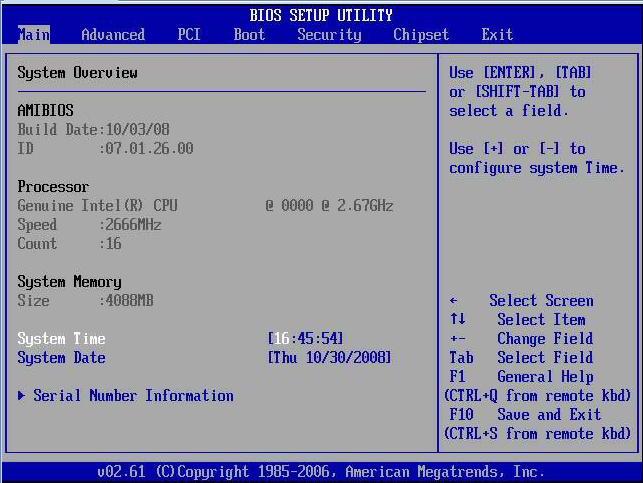
- In the BIOS Setup Utility screen, select the Advanced menu option.
The Advanced Settings screen appears.
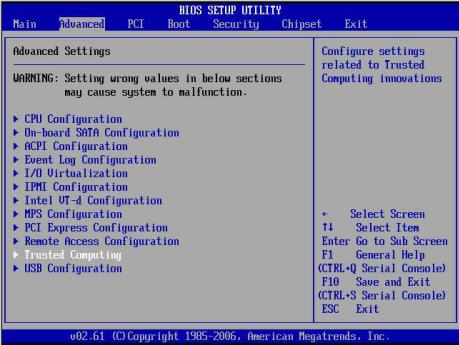
- In the Advanced Settings screen, select Trusted Computing and
press Enter.
The Trusted Computing screen appears.
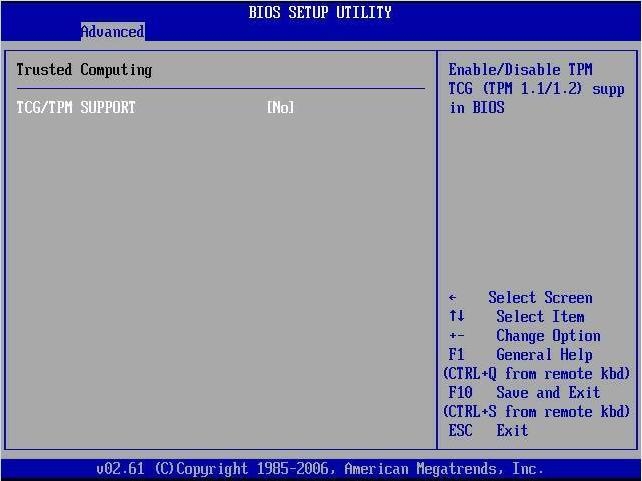
- In the Trusted Computing screen, select the TCG/TPM Support.
A pop-up dialog box appears.
- In the pop-up dialog box, set the TCG/TPM Support option to Yes
and click OK.
Note:
Even if the TCG/TPM Support was already set to Yes in the dialog shown above, continue on and complete the remaining steps of this procedure to ensure that all TPM configuration requirements are satisfied.The updated Trusted Computing dialog appears and shows that the TCG/TPM Support setting has changed to Yes.
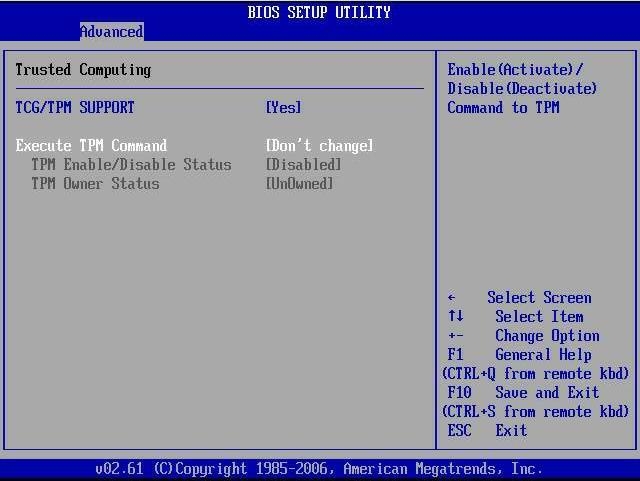
Note:
In the above screen, the Execute TPM Command setting shows the default, Don't Change. - In the Trusted Computing screen, select the Execute TPM Command
option setting.
A pop-up dialog box appears.
- In the pop-up dialog box, set the Execute TPM Command option to
Enabled and click OK.
The updated Trusted Computing screen appears and shows that the Execute TPM Command setting has changed to Enabled.
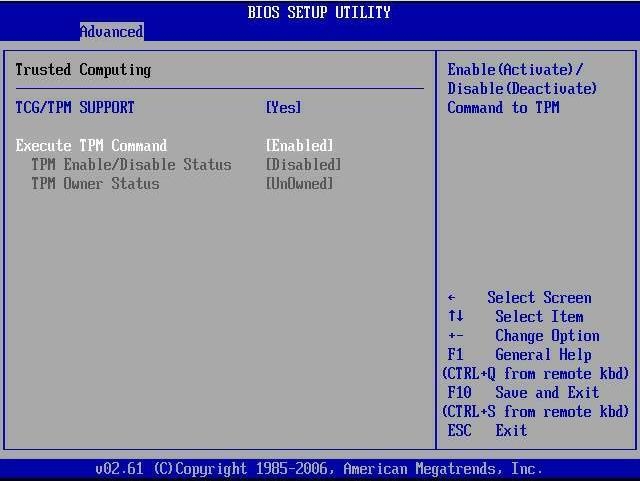
- Press F10 to save the changes and exit the BIOS Setup Utility.
- To verify that TPM support is configured, do the following:
- Reboot the server node.
- To enter the BIOS Setup Utility, press the F2 key while the system
is performing the power-on self-test (POST).
When BIOS is started, the main BIOS Setup Utility top-level screen appears.
- Select Advanced, then select Trusted Computing and press Enter.
The updated Trusted Computing screen appears.
Confirm that the TCG/TPM Support setting is set to Yes and the TPM Enabled/Disable Status is set to Enabled.
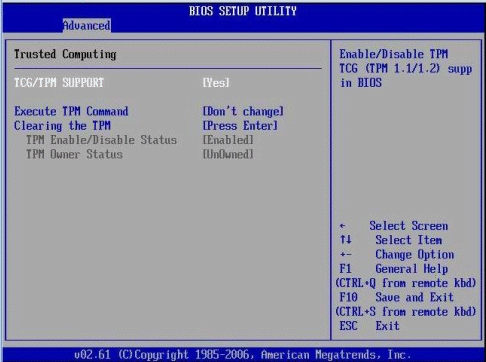
- Press F10 to exit the BIOS Setup Utility.
This completes the TPM configuration.
Configuring SP LAN Settings
You can assign an IP address for the Oracle Database Appliance (original version) server node SP from the BIOS Setup Utility on the IPMI LAN configuration menu. Alternatively, you can also specify the LAN settings for the SP using Oracle ILOM. For instructions for setting the IP address in Oracle ILOM, see Oracle Integrated Lights Out Manager (Oracle ILOM) 3.0 Documentation Collection.
Configure LAN Settings for SP
- Access the BIOS Setup Utility menus.
For instructions, see Accessing the BIOS Setup Utility Menus.
- In the BIOS Setup Utility menus, use the arrow keys (or Tab key) to navigate to the Advanced menu.
- In the Advanced menu, select IPMI Configuration.
- In the IPMI Configuration menu, select LAN Configuration.
The LAN Configuration screen appears.
- In the LAN Configuration screen, use the arrow keys to select
and specify the appropriate LAN configuration settings.
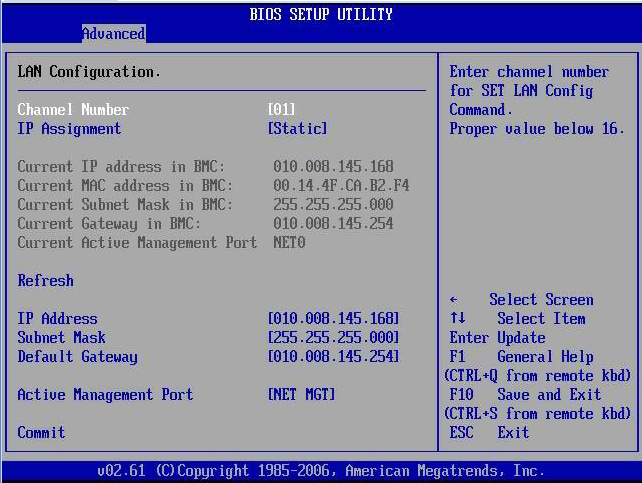
- After making the necessary changes, select Commit and press Enter to apply the changes.
- Press F10 to save the changes and exit BIOS.
Configuring Option ROM Settings in BIOS
The Oracle Database Appliance (original version) BIOS Option ROM space is 128 Kbytes. Of these 128 Kbytes, approximately 80 Kbytes are used by the VGA controller, the disk controller, and the network interface card. Approximately 48 Kbytes remain to be shared by the Option ROMs on all bootable PCI-Express plug-in cards.
Enable or Disable Option ROM Settings
- Access the BIOS Setup Utility menus.
For instructions, see Accessing the BIOS Setup Utility Menus.
- In the BIOS Setup Utility menus, use the arrow keys (or Tab key)
to navigate to the Boot menu.
The Boot menu appears.

- In the Boot menu, highlight the Option ROM setting, and then press Enter.
- Check whether the settings in your screen output match what is shown above. If they do not match, proceed to the next step. If they match, proceed to Step 7 and exit BIOS.
- To change the settings, in the Boot menu listing the Option ROM
settings, highlight the applicable Option ROM setting to modify, then press
Enter.
A dialog box appears listing the available settings.
- In the dialog box, do one of the following:
- Select –Enabled to enable the Option ROM setting.
- Select –Disabled to disable the Option ROM setting.
- Press F10 to save the changes and exit the BIOS Setup Utility.
BIOS Setup Utility Hot Keys
The following table provides a description of the Oracle Database Appliance (original version) BIOS Setup Utility Oracle ILOM Remote Console keys and the directly attached keyboard keys, and the corresponding serial connection key combinations.
| Oracle ILOM Remote Console Keys | Serial Connection Hot Key Combinations | Function |
|---|---|---|
|
F1 |
Ctrl+Q (Press and hold the Control key and type Q) |
Access the BIOS Setup Utility if there is an error during the boot process. |
|
F2 |
Ctrl+E |
Enter BIOS Setup Utility when the system has completed the power-on self-test (POST). |
|
F7 |
Ctrl+D |
Discard changes, but do not exit. |
|
F8 |
Ctrl+P |
Select the BBS Popup menu, which allows you to select a boot device. |
|
F9 |
Ctrl+O |
Load optimal BIOS defaults. |
|
F10
F10 is not supported on the Oracle ILOM Remote Console; instead, use the arrow keys to navigate to the Exit menu and press Enter. |
Ctrl+S |
Save changes and exit. |
|
F12 |
Ctrl+N |
Boot the server node from the network (PXE boot). |
Accessing the BIOS Setup Utility Menus
You can access Oracle Database Appliance (original version) BIOS Setup Utility screens from the following interfaces:
Use a USB keyboard, mouse, and VGA monitor connected directly to the server node.
Use a terminal (or terminal emulator connected to a computer) through the serial port on the back panel of the server node.
Connect to the server node using the Oracle ILOM Remote Console.
The following procedure describes the steps for accessing the BIOS Setup Utility menus.
Access BIOS Setup Utility Menus
- Power-on or power-cycle the server node.
- The following information appears on the screen:

- To enter the BIOS Setup Utility, do the following:
- Wait for the last line of the screen output to change to Initializing USB Controllers..Done
This will take several seconds.
- When Done appears, press the
F2 key immediately.
Note:
If there is an error during the boot process, you can press F1 to access the BIOS Setup Utility.The BIOS Setup Utility dialog appears.

Note:
If the BIOS Setup Utility dialog does not appear, you waited too long to press the F2 key. When Done appears on the screen, you must press the F2 key immediately. Try again.
- Wait for the last line of the screen output to change to Initializing USB Controllers..Done
- Use the left and right arrow keys to select the different menu options.
- As you select each menu option, the top-level screen for that menu option appears.
- To select an option on a top-level screen, use the up and down
arrow keys to scroll up and down the options presented.
Only options that can be modified are highlighted when you press the up and down arrow keys.
- If a field can be modified, as you select the option, user instructions for modifying the option appear in the right column of the screen.
- If a field is a link to a sub-screen, instructions to press the Enter key to access the sub-screen appear in the right column.
- Modify the setup field and press the Esc key to save the changes
and exit the screen.
Some screens present a confirmation dialog box that enables unwanted changes to be retracted.
- On sub-screens that only provide configuration information and cannot be modified, press the Esc key to exit the screen.
- To continue modifying other setup parameters, repeat Step 4 through Step 8. Otherwise, go to Step 10.
- Press and release the right arrow key until the Exit menu screen appears.
- Follow the instructions on the Exit menu screen to save or discard your changes and exit the BIOS Setup Utility.
BIOS Setup Utility Screens
This section describes the Oracle Database Appliance (original version) BIOS setup utility screens. It includes the following sections:
The BIOS utility includes seven top-level screens, many of which include sub-screens. Arrow keys provide navigation, and the options or fields that you can configure appear in color. Online instructions provide additional information.
Note:
The screens shown are examples. The version numbers and the screen items and selections shown are subject to change over the life of the product.BIOS Setup Utility Screen Overview
The following table contains summary descriptions of the Oracle Database Appliance (original version) top-level BIOS setup screens.
| Screen | Description | See This Section |
|---|---|---|
|
Main |
General product information, including BIOS type, processor, memory, and time/date. | |
|
Advanced |
Configuration information for the CPU, memory, IDE, Super IO, trusted computing, USB, PCI, MPS and other information. | |
|
PCI |
Configure the system to clear NVRAM during system boot. | |
|
Boot |
Configure the boot device priority (storage drives and boot disk drives). | |
|
Security |
Set or change the user and supervisor passwords. | |
|
Chipset |
View the configuration of system chip set. | |
|
Exit |
Save changes and exit, discard changes and exit, discard changes, or load optimal or fail-safe defaults. |
The following figures shows a map of the BIOS screens.
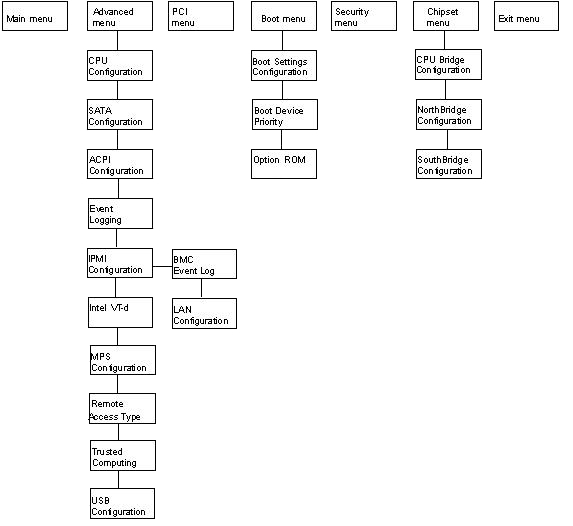
BIOS Main Menu Screen
The Oracle Database Appliance (original version) BIOS Main screen provides general product information, including BIOS, processor, system memory, and system time/date.

BIOS Advanced Menu Screen
The Oracle Database Appliance (original version) BIOS Advanced screen provides detailed configuration information for the CPU, memory, IDE, Super IO, trusted computing, USB, PCI, MPS and other system information.
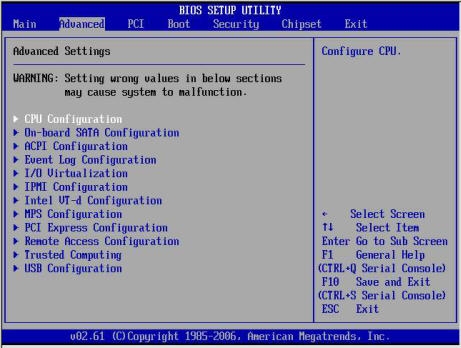
BIOS PCI Menu Screen
The Oracle Database Appliance (original version) BIOS PCI screen enables you to configure the server node to clear NVRAM during system boot.
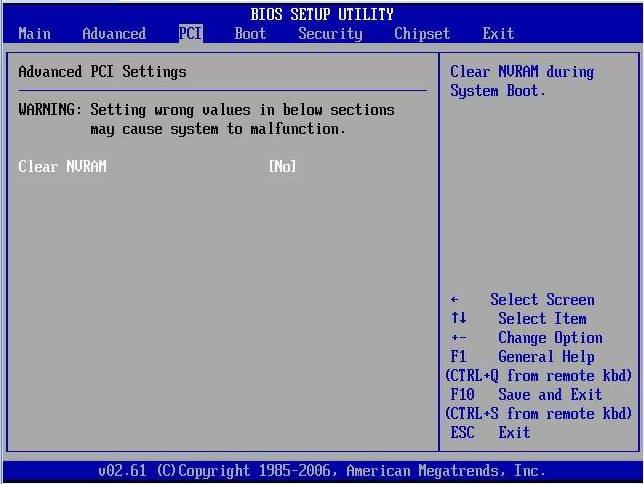
BIOS Boot Menu Screen
The Oracle Database Appliance (original version) BIOS Boot screen enables you to configure the boot device priority (storage drives and the DVD-ROM drive).
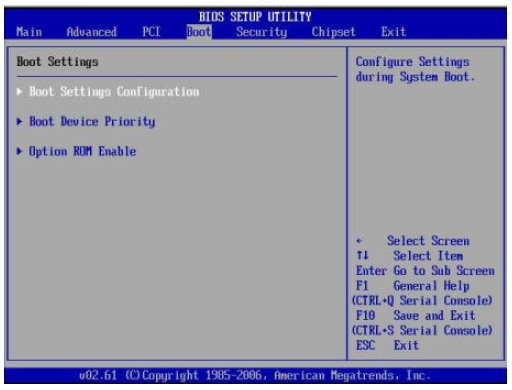
BIOS Security Menu Screen
The Oracle Database Appliance (original version) BIOS Security screen enables you to set or change the supervisor and user passwords. The default state is for the passwords to be unconfigured (not required).
If you configure a supervisor password, users must enter it to access BIOS setup.
If you configure a user password, users must enter it before booting an OS.
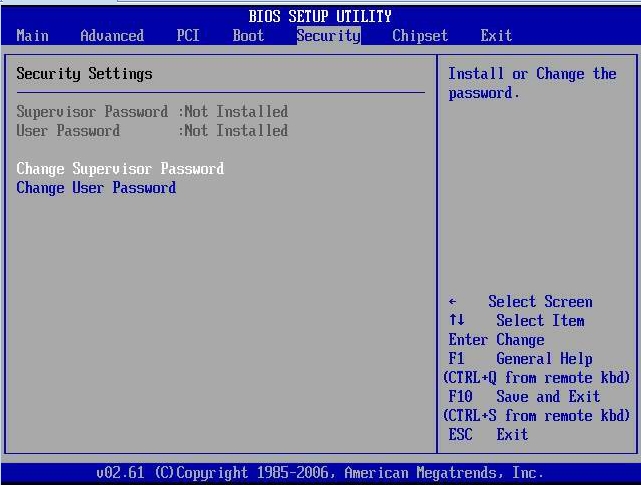
BIOS Chipset Menu Screen
The Oracle Database Appliance (original version) BIOS Chipset screen enables you to set the chipset parameters.
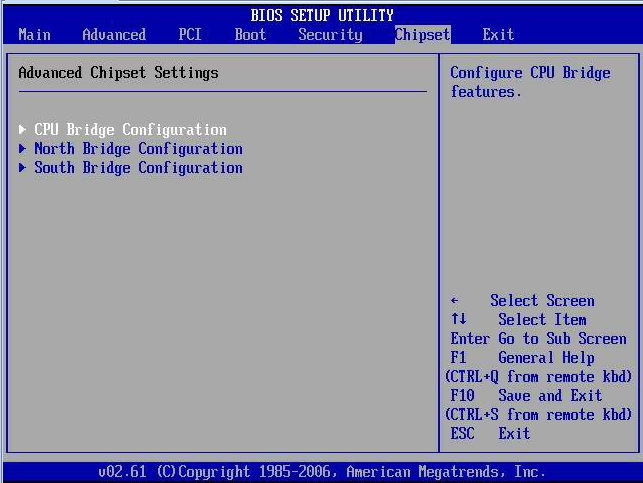
BIOS Exit Menu Screen
The Oracle Database Appliance (original version) BIOS Exit options enable you to save changes and exit, discard changes and exit, discard changes, or load optimal defaults.
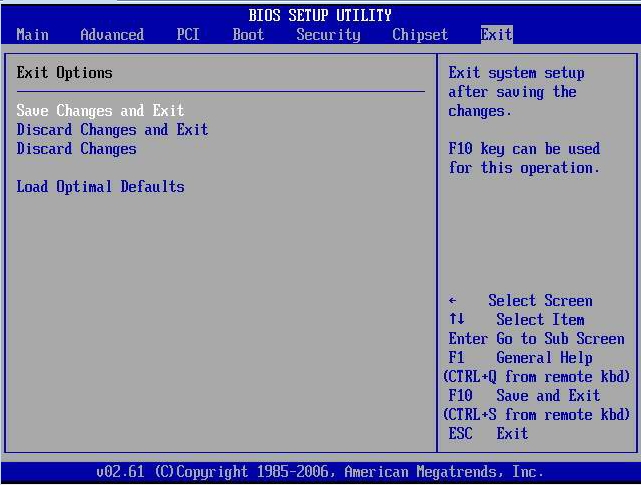
Exit From the BIOS Setup Utility
- Use the up and down arrow keys to scroll up and down the BIOS Exit options.
- Press Enter to select the option.
A confirmation dialog box appears that enables you to save the changes and exit the Setup Utility or cancel the exit option.
Note:
The confirmation dialog box is only shown below for the Save Changes and Exit option screen. The other exit confirmation screens work in a similar way.